ZEROtherm Nirvana: Designed for Top Performance
by Wesley Fink on January 16, 2008 5:00 PM EST- Posted in
- Cases/Cooling/PSUs
In the earlier review of the ZEROtherm BTF90 we were somewhat amused by the butterfly shape of the cooler with a 90mm fan. The shape appeared more a gimmick than anything that could improve performance, so we really didn't expect much from the cooler. However, the performance of that upper mid-range cooler was anything but laughable. Cooling performance was very solid, leading to the conclusion that "...this butterfly carries a pretty good punch, yet the sting is nearly silent - just the way we like it." That review posted last August, and since then ZEROtherm has been hard at work on a larger cooler aimed at the top of the cooler performance charts.
The new ZEROtherm Nirvana does not look like a butterfly, but the influence of the original butterfly-shaped BTF90 is clearly there in the cooling fin design. That is certainly a good thing if Nirvana works as well at the top of the cooling heap as BTF90 did for the less expensive 90mm mid-range coolers.
For those not familiar with ZEROtherm, it is the marketing division of a company called APACK, a company known more for targeting the OEM market. Since the success of Zalman as a cooling company based in Korea, other Korean companies have aimed for a slice of the enthusiast cooling pie. APACK is one of those companies who manufactures in Korea, and the ZEROtherm division is dedicated to marketing enthusiast level cooling solutions.
APACK was established in 1999 by three engineers from ETRI (Electrics and Telecommunications Research Institute) with extensive experience in thermal solutions and advanced packaging design (packaging meaning integration of multiple technologies). Based in the city of Daejeon (in the Korean Silicon Valley), APACK is still mainly an engineering company. Phase one of APACK's growth was producing OEM solutions for companies like Samsung, Dell, and LG. ZEROtherm is part of phase two, which is direct marketing of APACK thermal solutions.
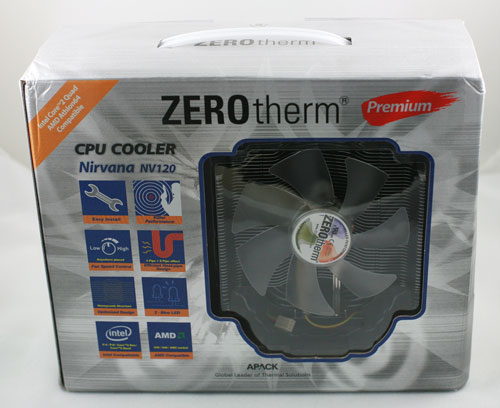
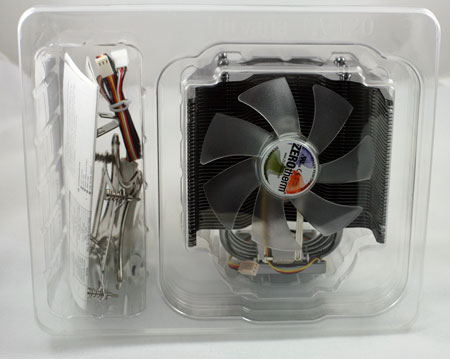
As the Nirvana builds on the success of the BTF90, it is no surprise that the packaging uses the same basic silver background and color scheme as the BTF90. However, like the cooler itself, the Nirvana doesn't carry the theme quite as far. The package is more basic without the distinctive sloped sides used in the BTF90 packaging.
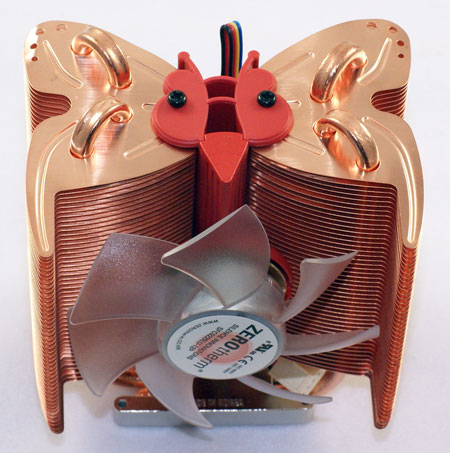
ZEROtherm BTF90
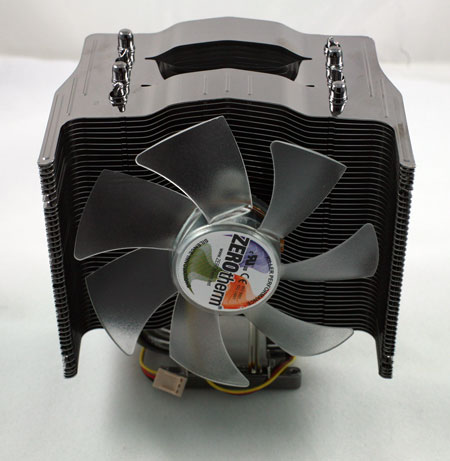
ZEROtherm Nirvana NV120
Inside the box you will find the fully assembled Nirvana NV120, including an integral and non-replaceable 120mm fan. The Nirvana uses the cooling fin shape that worked well on the BTF90, with the extensions that wrap around the fan. However, ZEROtherm did not highlight the butterfly shape as they did on the BTF90.
The smaller cooler was also all copper, where the Nirvana uses nickel-plated copper for the base and heatpipes. The Nirvana fins are aluminum and not pure copper as seen on the BTF90. Both coolers use four heatpipe loops, but the configurations are a bit different. The Nirvana is both larger and heavier than the BTF90 and it takes up more board and case real estate - hopefully with the result that it cools better.
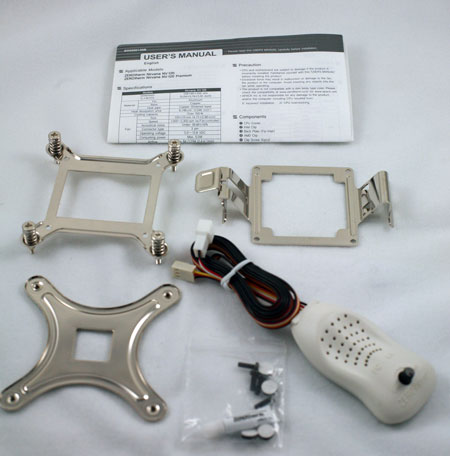
CPU and mounting options are very similar to the BTF90. Mounting hardware is included for Intel Socket 775 and AMD Socket 754/939/940/AM2. Also included is ZEROtherm thermal grease and a fan controller.
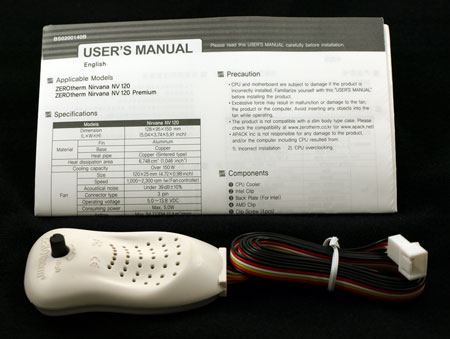
Also included in the Nirvana package are mounting screws and a multi-language user's manual. You get everything needed for installing the NV120 except a screwdriver.
The ZEROtherm Nirvana is an upgrade of the BTF90 to improve cooling with a 120mm fan and a larger, heavier cooler. Does the NV120 do what ZEROtherm intended? Is it a better cooler than the small and excellent BTF90?










38 Comments
View All Comments
Syzygies - Tuesday, March 11, 2008 - link
It's odd that AnandTech cooler reviews control other conditions to "average" (using fans as shipped in an average case, not decked out with optional fans) even while determining the maximum overclock, given that the AnandTech articles on overclocking are hands down the deepest overclocking articles on the web.I'm unwilling to go to water or more extreme cooling methods, but I've tried to get everything right "on air", e.g. 6 Scythe SFF21F fans in an Antec P182 case, two of the fans in "push-pull" configuration on a Thermalright Ultra 120 Extreme cpu cooler. (This required making harnesses from daisy-chained cable ties for the second fan, as the U120E only accepts one set of fan clips.) My Q6600 G0 Quad Core was stable at 3.6 Ghz but I didn't like the 67 C core temps at full load for 24/7 use, so I backed off to 3.2 Ghz, 60-62 C core temps at full load, which is cooler than my laptop. Lapping is in my near future, but not water.
These results are typical, and I am typical of a reader who studies the overclocking articles. So why assume "average joe" for the cooler articles? That's not your audience. The interesting comparison is against an U120E with two fans, or a Scythe Ninja with four fans. The question is "What's possible on air these days?" under ideal conditions. If I can get $1000 performance out of a $250 cpu for 24/7 use, the cost of the cooler and fans is not a significant factor.
Number1 - Friday, February 22, 2008 - link
I tried to purchase this unit but my local and favorite online store did not carry it. I ended up buying the Thermalright 120 extreme and I am happy with it. Good thing because there are significant problems the zerotherm unit. Another review site called it the hardware killer.Tom's Harware:
http://www.tomshardware.com/2008/02/20/cpu_cooler_...">http://www.tomshardware.com/2008/02/20/cpu_cooler_...
Zerotherm appalled us with its newest cooler product, the Nirvana NV120. We feel obligated to point out the dangers and risks that are associated with using this cooler. If you are not very careful when installing it, you can easily damage or even destroy your PC components.
The backplate, which is mounted in the back of the motherboard, is covered with a transparent adhesive foil. When removing the protective sticker from the backplate, it is far too easy to accidentally pull off this adhesive film too. As a result, the bare metal will press against the reverse side of the CPU socket, creating a short circuit that can destroy your entire motherboard. In the worst case, this can even affect other components as well.
Another reason we had to fail this cooler is that it, too, suffers from the already well-known problem with metal shavings. When you attach the cooler by fastening the screws, metal shavings can fall from the screws and springs and fall into the hardware of your PC - again causing a short circuit. This is not a new problem, but one that we've mentioned in previous reviews.
When running at its highest fan speed, the Nirvana NV120 achieves good cooling performance, able to cool the quad-core CPU to 65°C. However, it is unbearably loud at this setting. At its lowest speed, the CPU temperature rises to 74°C and the cooler is completely inaudible. Its noise level increases when the fan speed is raised by more than 33%. Thus, only the lowest fan speed will allow you to work without the cooler's noise becoming an annoyance.
BSMonitor - Saturday, January 26, 2008 - link
Thanks for the awesome review... Picked one up on newegg for $35. Smooth installation. Dropped Prime95 temps from 66-67 C with stock cooler down to 44 C with this puppy...ASUS P5W DH Deluxe Motherboard here. Fits nice and neat. Just clears the northbridge heatsink.
Rocket321 - Saturday, January 19, 2008 - link
I'd like to know how it compares to the Tuniq tower, especially with current pricing they are very close.Also, anyone know if either of these coolers have a problem fitting in the Antec solo case?
BOLt - Friday, January 18, 2008 - link
nice review but you said the same thing several times on the last and second-to-last pages. your quantitative analysis was superb, by the way.piasabird - Thursday, January 17, 2008 - link
How does the CPU cooler compare to something like this:COOLER MASTER ICT-D925R-GP 95mm Rifle CPU Cooler - Retail
This particular model is rather small and compact, but only costs about $12.00.
I just built a Quad with a Q6600 and I was not happy with the stock cooler assembly. It feels like you are going to break the motherboard attaching it. If I build another computer it will be with something like this. I dont feel like I can trust the Mickey Mouse mounting technique that Intel came up with. Having a back mounting plate seems like a more desirable option.
chick0n - Thursday, January 17, 2008 - link
Seriously, this is my first Aftermarket coolers, cuz I was thinking, stock cooler should be enough for me. Not like I overclock or anything right?Oh, forgot to mention, I got ASUS's Megatasking board, Yep the L1N64. Dual Athlon Fx-70. I got only 1 Cooler cuz my case cant fit 2 (its gonna hit the harddrive)
Stock cooler is about 50-52 celsius when idle, and 62-70 under full load.
With this cooler(the 120mm fan one), idle drop down to about 30-32 !!!! and its about 40-ish under full load !!!
I was like WOW ... thats a huge drop in temp. :) I turn it up to highest and its still not noisy, hell even my 8800 GTX's fan sound louder.
This is a Great cooler, But only if your motherboard and case can fit.
mustardman - Thursday, January 17, 2008 - link
I've always had a problem with the noise level sections of these articles. They really give no useful information other than the item being reviewed is quieter than the test system or louder.I want to know if the item will add any noise to my system. What if I have a completely passively cooled system and therefore completely quiet. How much noise will this device add? What if my system is 25db? How much noise will this device add?
Maybe I'm missing something. But, for me, to say it adds no noise to our 38db system means very little.
Wesley Fink - Thursday, January 17, 2008 - link
Our current system sound floor is 36.5 dBa at 24" from the test system and 37.8 dBa at 6". You can compare this to the above noise charts and see that our test environment is VERY quiet, considering the PS is running a fan.I hop this answers what 36.5 bDa sound level actually means, when combined with the noise level charts above.
Wesley Fink - Thursday, January 17, 2008 - link
From a University article on Sound levels:Some Examples of Typical Noise Levels in dBA
Sound Level
in dBA Example
200 200 meters from Saturn V rocket at liftoff.
160 Peak level at ear of a person firing a 30-30 rifle.
140 25 meters from jet aircraft.
120 Submarine engine room. On stage at a rock concert.
100 Noisy factory. Jackhammer (unsilenced).
90 7 meters from large diesel truck.
85 Upper limit of comfort.
80 1 meter from ringing alarm clock. Conversation is difficult. After a 1-hour exposure, thought is difficult and the stomach contracts.
75 Railroad carriage. Normal conversation not possible. Consensus of experts is that sound levels below 75 dBA "are unlikely to cause permanent hearing damage."
70 Small car at 30 mph; 3 meters from a vacuum cleaner.
65 1 meter from normal conversation. Busy office. About half the people in a large sample will have difficulty sleeping.
55 Recommended upper limit for large open offices, restaurants, gymnasiums, swimming pools.
45 Recommended upper limit for homes, hotels, laboratories, libraries, private offices, court rooms.
40 Quiet office. Recommended upper limit for classrooms, churches, motion picture theaters (without the film soundtrack).
35 Quiet bedroom.
25 Countryside on windless day, away from traffic.